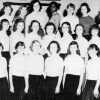calsfoundation@cals.org
Desegregation of Ozark Schools
Following the U.S. Supreme Court’s 1954 Brown v. Board of Education school desegregation decision, Ozark (Franklin County), a town of around 1,800 residents in the Arkansas River Valley, announced that it would desegregate its high schools in September 1957.
Previously, African American high school students in Ozark had been bused thirty-nine miles to the historically Black Lincoln High School in Fort Smith (Sebastian County). There were no plans to end segregation at the elementary level, since Ozark operated its own segregated Carver Elementary School, with eighteen Black students in attendance.
Desegregating Ozark High School meant admitting three Black students along with 475 white students. The three Black students were sixteen-year-old Inola West, her eighteen-year-old brother Rayford West, and sixteen-year-old Nola Blanche Kuykendoll. Superintendent of Schools R. L. Graves assured the white population that there would never be more than six Black students in high school at one time.
Ozark High School integrated in September 1957 on the heels of unsuccessful attempts to desegregate Central High School in Little Rock (Pulaski County) the week before. Events in the state capital, which made international headlines, stiffened opposition to school desegregation across the state.
The three Black students at Ozark High were harassed by white students and sent home for their own safety. Riley West, the father of Inola and Rayford West, explained that a white boy had hit Nola Kuykendoll with a clothes hanger and that his son had been hit in the back with a book. West further revealed that his children had almost been run over by a white driver as they walked home from school.
Superintendent Graves suspended eight white students for harassing the Black students, but he allowed them back into school on condition that they agreed to behave. The three Black students reentered the school without incident following the mid-term break in January 1958, after federal soldiers had been sent into Little Rock to oversee the integration of Central High School. The three Black students in Ozark stayed in high school for the rest of the semester without any further incidents.
In 1958, events in Little Rock again derailed attempts to desegregate in Ozark. Governor Orval E. Faubus closed all of Little Rock’s high schools for the 1958–59 school year to prevent desegregation. Little Rock voters backed this move in a referendum. This rekindled violent white resistance to school desegregation in Ozark. When Nola Kuykendoll returned to school that year along with two new Black students, fourteen-year-old Ivy West and thirteen-year-old Joan Johnson, a group of ten white students attacked them.
The three Black students left the school and refused to return without an assurance of protection. The school board proposed busing the three Black students to a Black school twenty-three miles away in Clarksville (Johnson County) rather than continuing with school desegregation in Ozark. Two of the Black students accepted the offer, but the third, the daughter of Frank Johnson, the only teacher at Carver Elementary, did not. Johnson resigned his position at Carver and moved with his family to Kansas.
In fall 1959, no Black students attempted to enroll at Ozark High School, and the busing arrangement remained in place. It was not until 1965, through federal pressure exerted by the Civil Rights Act of 1964, that Ozark finally desegregated all grades and closed Carver Elementary.
For additional information:
Kirk, John A. “Not Quite Black and White: School Desegregation in Arkansas, 1954–1966.” Arkansas Historical Quarterly 70 (Autumn 2011): 225–257.
John A. Kirk
University of Arkansas at Little Rock
 Civil Rights and Social Change
Civil Rights and Social Change Education, Elementary and Secondary
Education, Elementary and Secondary School Desegregation Timeline
School Desegregation Timeline World War II through the Faubus Era, 1941 through 1967
World War II through the Faubus Era, 1941 through 1967



Comments
No comments on this entry yet.